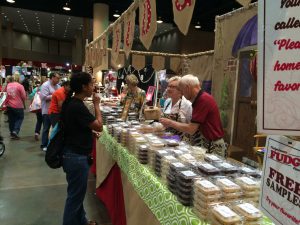 Looking for something sweet? You need to check out Fudge Etc!
Looking for something sweet? You need to check out Fudge Etc!
Janet and Wallace Heggie are the owners of a specialty fudge business located in Meridian, MS and they create some of the creamiest, tastiest fudge you will ever put in your mouth. Fudge is one of those interesting sweet treats that requires a little bit of chemistry, a knowledge of sugar crystals and a lot of patience. Many people find making their own fudge more than a little daunting, but it’s a lot less scary now that Fudge Etc is in your corner!
The basic recipe for fudge is to mix sugar, butter and milk, heat it to the soft-ball stage at 240 °F (116 °C), and then working or beating the mixture while it cools so it will take on a smooth, creamy consistency. As they say, its easier said than done.
Fudge has been around for a long time and may have actually been discovered by accident:
From HowStuffWorks: Although the origins of many foods are in doubt, there’s a strong suggestion that fudge was first created in the Eastern United States in the late 1800s and is the result of a happy accident made by one, or possibly a group of Vassar College students attempting to make caramels. We find the first mention of it in a letter written by Emelyn Battersby Hartridge about a recipe she’d obtained from the cousin of a school friend.
No one knows if fudge started life with its distinctive name, or just exactly how the name became popular, but by 1895, carrying the “fudge” moniker, it appeared in a nationally syndicated write up in the Boston Globe. Fudge had made the big time [source: Practically Edible].
Wikipedia claims that “Hartridge obtained the fudge recipe and, in 1890, made 30 lb (14 kg) of fudge for the Vassar College Senior Auction. This Vassar fudge recipe became quite popular at the school for years to come. Word of this popular confectionery spread to other women’s colleges. For example, Wellesley College and Smith College have their own versions of a fudge recipe dating from the late 19th or early 20th century.”
But here’s the key:
Controlling the crystallization of the supersaturated sugar solution is the key to making smooth fudge. Initiation of crystals before the desired time will result in fudge with fewer, larger sugar grains. The final texture would then have a grainy mouthfeel rather than the smooth texture of high quality fudge.
[Wikipedia]
I’ve had a lot of fudge with that grainy mouthfeel and I gotta tell you, it’s not always pleasant. When a fudge has large sugar crystal, you lose a lot of the flavor and it takes on the consistency of pralines. Now I’m going to upset some folks with this, but I’ve never been a fan of the pralines (I know there are a lot of people who are, just being honest here) and I think a lot of that is based on the texture of pralines.
Fudge Etc. has somehow figured out how to avoid grainy texture in their different flavors and perhaps the secret is found right on their website. Their secret recipe has been developed through a lot of trial & error but each batch is made with their families traditional care and concern. They started making just five (5) flavors of fudge and now their product line includes everything from chocolate to sweet potato flavored fudge.
If you want to learn more, contact them:
1-800-218-9033
fudgeetc@bellsouth.net
Fudge Etc.
5011 Poplar Springs Drive
Post Office Box 3083
Meridian, MS 39303
Or better yet, just visit their website and place an order today!



